
The Antofagasta Region is one of Chile's sixteen first-order administrative divisions. The second-largest region of Chile in area, it comprises three provinces, Antofagasta, El Loa and Tocopilla. It is bordered to the north by Tarapacá, by Atacama to the south, and to the east by Bolivia and Argentina. The region's capital is the port city of Antofagasta; another one of its important cities is Calama. The region's main economic activity is copper mining in its giant inland porphyry copper systems.

Mejillones is a Chilean port city and commune in Antofagasta Province in the Antofagasta Region. Its name is the plural form of the Spanish mejillón meaning "mussel", referring to a particularly abundant species and preferred staple food of its indigenous inhabitants. It is situated in the northern side of the Mejillones Peninsula, 60 km north of the city of Antofagasta. To the west, in the northern part of peninsula, is Punta Angamos, the site of the naval combat of the same name, fought during the War of the Pacific (1879-1883).
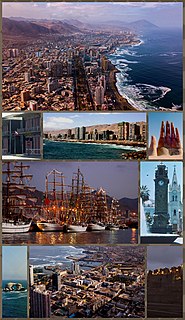
Antofagasta is a port city in northern Chile, about 1,100 kilometres (700 mi) north of Santiago. It is the capital of Antofagasta Province and Antofagasta Region. According to the 2015 census, the city has a population of 402,669.
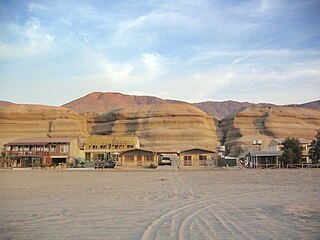
Hornitos is a coastal town located 25 km (16 mi) north of Mejillones and 90 km (56 mi) north of Antofagasta in Chile's Antofagasta Region. Hornitos is part of the Mejillones commune, but its residents are mainly Antofagasta inhabitants. Nearly 300 houses comprise the town, but almost none of them are inhabited during the winter.

The Trans-Andean railways provide rail transport over the Andes. Several are either planned, built, defunct, or waiting to be restored. They are listed here in order from north to south.
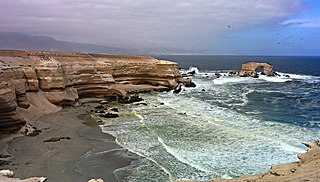
Antofagasta Province is one of three provinces in the northern Chilean region of Antofagasta (II). The capital is the port city of Antofagasta. Located within the Atacama Desert, it borders the El Loa and Tocopilla provinces to the north, the Pacific Ocean to the West and the Atacama Region to the south.

Hilarión Daza Groselle was a Bolivian military officer who served as the 19th president of Bolivia from 1876 to 1879.

The Ferrocarril de Antofagasta a Bolivia is a private railway operating in the northern provinces of Chile. It is notable in that it was one of the earliest railways built to 2 ft 6 in narrow gauge, with a route that climbed from sea level to over 4,500 m (14,764 ft), while handling goods traffic totaling near 2 million tons per annum. It proved that a railway with such a narrow gauge could do the work of a standard gauge railway, and influenced the construction of other railways such as the Estrada de Ferro Oeste de Minas. It was later converted to 1,000 mmmetre gauge, and still operates today.

International relations between the Republic of Chile and the Plurinational State of Bolivia have been strained ever since independence in the early 19th century because of the Atacama border dispute. Relations soured even more after Bolivia lost its coast to Chile during the War of the Pacific and became a landlocked country. Chile and Bolivia have maintained only consular relations since 1978, when territorial negotiations failed and Bolivia decided to sever diplomatic relations with Chile. However, in spite of straining relationship, Chile and Bolivia still have economic treaties supporting tourism and cooperation; therefore, trading between two nations is not affected by the territorial dispute.
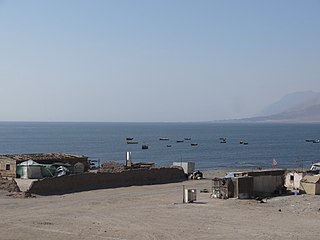
Cobija in 2002 it had 41 inhabitants and its economy was totally based on fishing. was the first significant Pacific Ocean port of independent Bolivia.
Sierra Gorda is a Chilean commune in Antofagasta Province, Antofagasta Region. The total population was 1,516 as of the 2012 census. The two main settlements are the villages of Sierra Gorda and Baquedano.

Taltal is a Chilean commune and city in Antofagasta Province, Antofagasta Region. According to the 2012 census, the commune has a population of 11,132 and has an area of 20,405.1 km2 (7,878 sq mi). The commune is home to Paranal Observatory and includes the northern portion of Pan de Azúcar National Park.
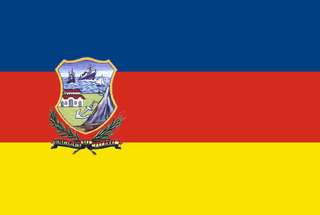
The Department of the Litoral, also known as the Atacama Department and commonly known as the Bolivian coast, was the description of the extent of the Pacific coast of the Atacama Desert included in the territory of Bolivia from its inception in 1825 until 1879, when it was lost to Chile.

The Arica–La Paz railway or Ferrocarril de Arica–La Paz (FCALP) is built by the Chilean government under the Treaty of Peace and Friendship of 1904 between Chile and Bolivia. The railway line was inaugurated on 13 May 1913 and is the shortest line from the Pacific Coast to Bolivia. It is 440 km (273 mi) long, of which 233 km (145 mi) is in Bolivian territory. The Railway is meter gauged. However, until 1968, it was rack worked over a 43 km section, on the Chilean side, between Central and Puquios. The line reaches a height of 4257 meters above sea level at General Lagos. The Chile - Bolivia border is crossed between the stations of Visviri and Charaña. When the railway is in operation, it is used for the export of Bolivian minerals and some agricultural production as well as the import of merchandise into Bolivia.

Mejillones Peninsula protrudes from the coast of northern Chile north of Antofagasta and south of the port of Mejillones.
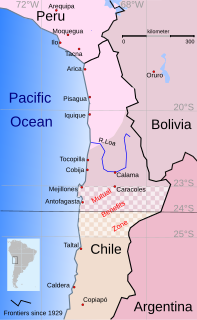
The Boundary Treaty of 1874 between Chile and Bolivia, also called the Treaty of Sucre, was signed in Sucre on August 6, 1874 by the Bolivian Minister of Foreign Affairs Mariano Baptista and the Chilean plenipotentiary minister Carlos Walker Martínez. It superseded the Boundary Treaty of 1866 between Chile and Bolivia and it kept the border between both countries at the 24° South parallel from the Pacific Ocean to the eastern border of Chile.

The Raids of the Huáscar were a series of raids that occurred by the Peruvian ironclad Huáscar under the command of Miguel Grau Seminario during the War of the Pacific. The actions kept the Chilean government in check for nearly five months which ended after the Battle of Angamos.

The First Battle of Antofagasta or the Bombardment of Antofagasta was a battle of the War of the Pacific as it was the first nightly raid of the War as well as the first raid of the Huáscar in a campaign to destroy and capture Chilean ports and ships.

The Capture of the steamer Rímac or the Hunt and seizure of the Chilean transport Rímac was a part of the Raids of Huáscar during the Naval campaign of the War of the Pacific. During an expedition over the conflicting seas, the Peruvian Navy ships, Huáscar and Unión, apprehend the Chilean war steamer Rímac, which was an artillery transport, taking all its cargo and capturing its crew, including a squad of the Carabineros de Yungay. In Chile, the news of the capture of the Rímac detonated a political and social crisis that led to the resignation of several government officials, including Rear Admiral Juan Williams Rebolledo, Commander General of the Chilean Navy.

The Second Battle of Antofagasta was a battle that took place during the Naval campaign of the War of the Pacific between the Peruvian ironclad Huáscar against the Chilean corvettes Abtao and Magallanes as well as the land defenses at Antofagasta.


















